 The two keywords for last week’s update were “continued progress,” and those would work for this week as well. As this is the first update for May, however, let’s take a look at the progress over the past month, since the start of April. While weekly data is useful, the pandemic has now continued on for long enough that we have the data to establish a broader context—and that broader context is surprisingly positive.
The two keywords for last week’s update were “continued progress,” and those would work for this week as well. As this is the first update for May, however, let’s take a look at the progress over the past month, since the start of April. While weekly data is useful, the pandemic has now continued on for long enough that we have the data to establish a broader context—and that broader context is surprisingly positive.
Pandemic slowing even further
Growth rate. You can see from the chart below that the new case growth rate went from more than 15 percent per day at the beginning of April to the present level of about 2 percent per day. Put another way, the number of new cases was doubling in less than a week at the start of April; as we enter May, that doubling rate has gone to more than five weeks. This shift is a significant improvement—we have succeeded in flattening the curve at a national level.
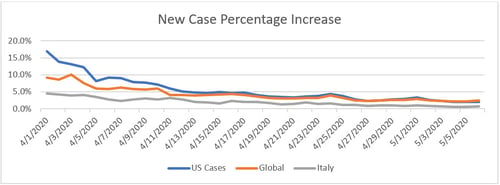
Source: Data from worldometer.com
Daily testing rate. We have also made real progress on testing, with the daily test rate up from just over 100,000 per day at the start of April to well over 200,000 per day at the start of May. While this level is still not where we need it to be, it represents real progress.
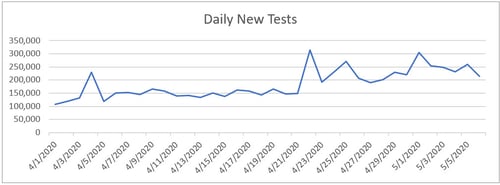
Source: Data from the COVID Tracking Project
Positive test results. Another way of seeing this progress is to look at the percentage of each day’s tests that are positive. Ideally, this number would be low, as we want to be testing everyone and not just those who are obviously sick. The lower this number gets, the wider the testing is getting. Here again, we can see the positive level has halved from the peak. More people are getting tests, which means we have a better grasp of how the pandemic is spreading.
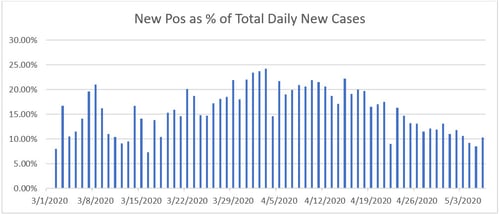
Source: Data from the COVID Tracking Project
New cases per day. The improvement in new cases per day is less dramatic, down from 30,000-35,000 to about 25,000. But this number is better than it looks. With the wider range of testing and with the number of tests doubling, other things being equal, we would expect reported cases to increase in proportion to the number of tests. In fact, we have seen the number of daily cases ebb and flow with the testing data. But overall the trend is down—by more than 20 percent from the start of April—despite the doubling in the number of tests.
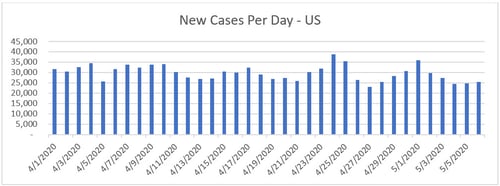
Source: Data from worldometer.com
We continue to make progress on controlling the coronavirus pandemic, but the point this week is how much progress we have made. We are not out of the woods yet. But we are at the end of the beginning of the process and moving in the right direction.
Economy may have bottomed in April: Reopening begins
While layoffs continue, there are signs that the damage may have peaked and is starting to recede. Weekly initial unemployment claims are down by more than half from the peak, suggesting that much of the damage has already been done. If the decline continues at this pace, we could see layoffs normalize in the next month. That decline does not mean the economy is good. It does mean the economy is getting less bad, which is a necessary step in getting to good.
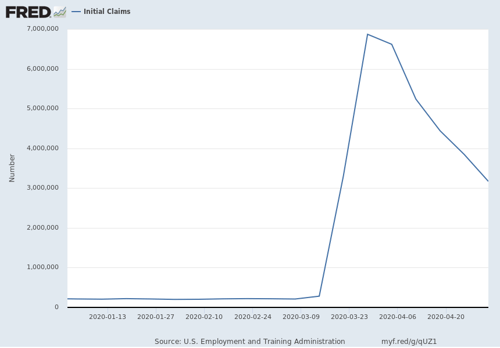
Federal aid. Even as the economic damage mounts, the federal aid is also mounting. At the start of April, the programs were not in place. Now, substantial amounts of cash are flowing into the economy via the stimulus payments, expanded unemployment insurance, and loan programs for businesses, which should help keep demand alive until the economy reopens (which might not be that long).
Benefits of reopening. Several European countries have started to reopen their economies since the start of May, and a number of U.S. states are opening as well. As we reopen, we certainly face risks, but there are also real benefits. First, the emerging fact that the lockdown does indeed have an end should help support consumer confidence, which is a necessary ingredient of any recovery. Second, it will help employment and spending, bringing some of those laid-off employees back to work. Third, we will learn a lot about how the reopening works, which will substantially reduce uncertainty going forward.
Are there risks? Certainly, the biggest of which is a second large wave of the pandemic. Reopening means loosening the social-distancing restrictions and exposing more people to infection risk, which could certainly inflate case counts. At the same time, if people continue to do things like wear masks and maintain distance, that additional case growth might be minimal. That will be something we will learn, and it seems probable that most people will act in a safe manner.
Another potential risk is that, even with the reopening, consumers will be slow to return and spending growth will not return to what was normal any time soon. This outcome seems probable, especially in the early stages. Here again, this is something that could end up doing better than expected.
We will have to reopen at some point. If we can do so without too much additional infection risk, that will be worth finding out. And, the bigger-picture perspective here is that at the start of April, we didn’t know whether we would control the pandemic or not. And a month later? We are planning to reopen in many areas. This is real progress.
Market implications. For the financial markets, right now the assumption is that the reopening and recovery will go well and quickly. Markets are priced for a rapid end to the pandemic and a V-shaped economic recovery. If the May reopening goes well, those assumptions will look much less uncertain—to the likely further benefit of the markets.
Risks in the rearview?
Looking back over a month, the surprising thing is just how much progress we have made and how we have moved from something approaching panic to a measured approach to reopening the economy. We are not yet out of the woods, and there are certainly significant risks going forward, with a second wave of infections being the biggest. But the thing to keep in mind is that many of the biggest risks are moving behind us.


 Print
Print

